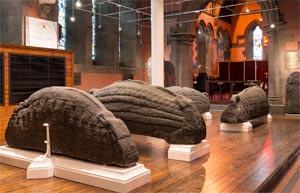Rare ‘Hogback Stone’ moved for the first time in a millennium
Published: 27 January 2014
A half-tonne early-medieval gravestone has left Scotland for the first time in its 1,100 year history as it becomes part of a new exhibition at the British Museum
A half-tonne early-medieval gravestone has left Scotland for the first time in its 1,100 year history, moving to London for the opening of a new exhibition at the British Museum.
One of five rare ‘Hogback Stones’ was moved from Govan Old Church to form part of a new exhibition called ‘Vikings: Life and Legend’ that will run at the British Museum until June 2014.
 The stone is one of the famous ‘Govan Stones’, which are on permanent display in Govan Old Church and form one of Scotland’s most important cultural artefacts.
The stone is one of the famous ‘Govan Stones’, which are on permanent display in Govan Old Church and form one of Scotland’s most important cultural artefacts.
In the Ninth century AD Govan was the political, administrative and spiritual capital of the ancient Britons, the seat of the kings of Strathclyde and one of the most important centres in the UK.
The collection in Govan is the largest collection of Hogback Stones in one place in the UK and offers a unique window into a relatively little known period of British history.
The stone is an example of an ornately carved gravestone which was made to mark the resting place of one of the ancient kings of Strathclyde. Around the time that the Vikings were conquering much of northern Europe, the kingdom of the Britons covered a large part of southern Scotland and northern England.
The easily recognisable carved designs on the Hogback Stones are thought to represent stylised Viking houses for the dead and this mix of influences denotes an increasing exchange of ideas and cultural practices between the Norsemen and the Britons, which remain engrained within Scottish culture to this day.
Stephen Driscoll, Professor of Historical Archaeology at the University of Glasgow, said: The Govan Stones are central to our understanding of the important but poorly documented kingdom of Strathclyde. Their presence gives us clues towards the complex and evolving society that existed within the region at this time. While the wording on the stones is mostly Celtic, the shape and some of the designs are taken from the Viking tradition, giving us the idea that the old kingdom was a melting pot of indigenous Celtic and Briton cultural influences and newer Norse ones.”
The stone will take its place as part of the inaugural exhibition for the Sainsbury Exhibition Gallery, a custom-built space currently being built as part of the British Museum’s new World Centre for Exhibitions and Conservation.
For more information please contact Nick Wade, Media Relations Officer, University of Glasgow: 01413307126 or at nick.wade@glasgow.ac.uk
Read more about the Govan Stones from the BBC: http://www.bbc.co.uk/news/uk-scotland-18172678
First published: 27 January 2014
<< January

